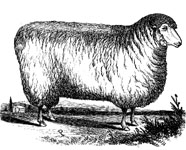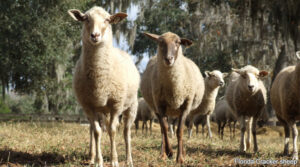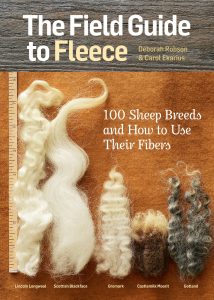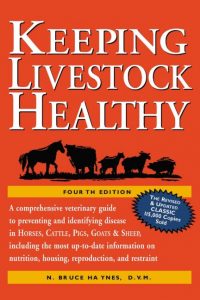
Breed Facts
Status:
Critical
Use:
Meat, Wool
Adult Weight:
Rams: 135-200 lbs. Ewes: 85-135
Temperament:
Alert, Docile
Experience Level:
Novice – Intermediate
Notes:
Usually polled; heat tolerant; parasite resistant; can handle low-grade forages
FLORIDA CRACKER SHEEP
Florida Cracker sheep are one of the oldest sheep breeds in North America. It is believed that they developed from sheep first brought to the southeastern US by the Spanish in the 1500s. The sheep developed largely through natural selection under the humid, semitropical range conditions of Florida.
It is possible that the foundation breed was the Churra Lebrijana which was found in the area around the port of Cadiz, so they would have been easy to obtain to take along on ships going to the Spanish missions in America.
Florida leadership eventually passed from the Spanish to the British, then back to the Spanish, then finally to the Americans. During this time, the Spanish missions were abandoned and their sheep were left to roam and fend for themselves.
Churra is Spanish for “scrub sheep” and the breed was known as “Florida Scrub Sheep” at one time. Over hundreds of years they adapted to the variable environment of Florida and the sheep that survived passed these genetics to their offspring. They can survive heat and cold, high winds, poor forage, and drought. They are hardy, disease resistant, pest resistant, are low maintenance, and lamb easily. The breed not only survived but thrived.
Before the Civil War, Florida was the leading sheep-producing state and, prior to World War II, most of the wool used in the South was provided by Florida Cracker Sheep. Prior to the end of open range in 1949, they free-ranged in the pastures, palmettos, and pineywoods. Twice a year, they were rounded up for shearing and to mark lambs.
In the middle of the 20th century, emphasis on high-input agriculture caused the sheep industry to turn to larger breeds of sheep that produced more wool and meat. This caused Florida Cracker numbers to decline dramatically, endangering its very existence. Fanciers and supporters began to work to save this important part of Florida’s history. According to Ralph Michael Wright in Florida Cracker Sheep: A Forgotten Part of Florida’s History, “Formerly called Florida Native sheep, the name was changed to Florida Cracker sheep to better reflect their heritage and to differentiate them from other breeds using the name “native”. A statewide census was done to locate and document flocks that might still exist. This census included contacting every county extension office and state laboratory, as well as colleges and universities throughout the state. During the census, one previously undocumented flock was discovered. That flock had existed on a large ranch in South Florida since at least the 1870s. When unforeseen events created the possibility of these sheep being sold for slaughter at a livestock market, association members stepped in and purchased the flock.
In 2007, the Florida Cracker Sheep Association was formed. Now, with renewed interest in low-input, sustainable agriculture, interest in Florida Cracker sheep is increasing once again.
Florida Cracker sheep are both active and vigorous without any tendency to be wild. They are a moderate-size breed with rams averaging 135-200 lbs. and ewes 85-135 lbs. They have wool on their bodies and shorter hair on their legs, belly, and head to behind their ears. They demonstrate greater resistance to internal parasites than wool sheep and most hair-sheep breeds. The ewes can breed back one month after lambing and can produce two lamb crops per year. Ewes usually bear twins, with some singles, frequent triplets, and occasional quadruplets; lambing rates vary from 150 to 200%. They have good milk production.
This landrace breed has a gentle nature and is a good option for both small and large farms. They can handle harsh conditions and low-grade forages. With their strong parasite resistance, high lamb survivability, heat tolerance, excellent mothering instincts, mild meat flavor, and good flocking, and with renewed interest in low-input, sustainable agriculture, the Florida Cracker has much to offer shepherds in the US.
Did you know:
When farms and farmers face a crisis, rare livestock breeds are more likely to be lost. That’s why The Livestock Conservancy offers Emergency Microgrants year-round. As the economy tightens, off-farm jobs are lost, herds are downsized, veterinary emergencies happen, and calamities such as floods, fires, and tornadoes continue. Help us help them. Click here to support the Emergency Response Fund with your gift today.
You may be interested in…

Breed Facts
Status:
Critical
Use:
Meat, Fiber
Adult Weight:
90 -180 lbs
Temperament:
Alert, Docile
Experience Level:
Novice – Intermediate
Notes:
Usually polled, heat tolerant, parasite resistant
You may be interested in…




